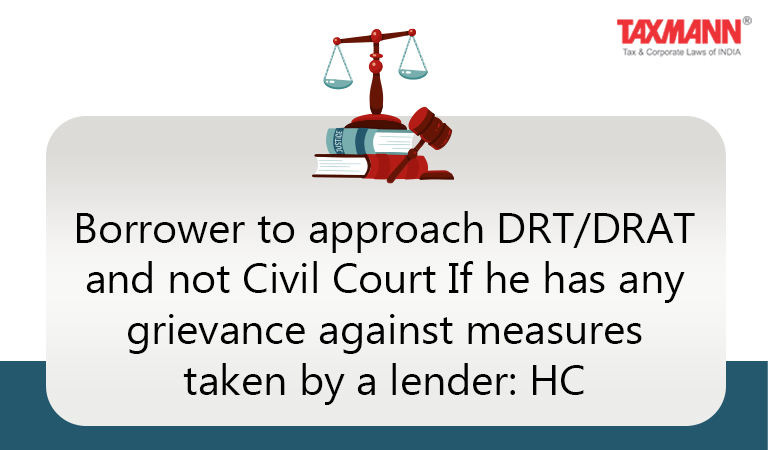Borrower to approach DRT/DRAT and not Civil Court If he has any grievance against measures taken by a lender: HC
- News|FEMA & Banking|
- 3 Min Read
- By Taxmann
- |
- Last Updated on 20 September, 2021
Case details: Rudra Bhattacharya v. Authorised Officer, Bank of India - [2021] 130 taxmann.com 173 (Calcutta)
Judiciary and Counsel Details
-
- Sabyasachi Bhattacharyya, J.
- Rudra Bhattacharya for the Petitioner.
- Ramesh Chandra Prusti and Sajib Das for the Appellant. for the Respondent.
Facts of the Case
In the instant case, the petitioner took various loan facilities from the respondent bank and as security for such loans, the property in question was kept inequitable mortgage by the petitioner with the bank. As a result, the accounts of the petitioner were declared NPA (Non -Performing Assets) due to the petitioner having defaulted in repayment of the said loans/credit facilities. Thus, the bank took physical possession of the subject property.
However, the petitioner alleged that the bank had taken possession illegally without the appropriate order of the District Magistrate. It also alleged that the bank also sized movable assets from said property. The value of said movables had been alleged to be Rs. 16,72,762 whereas, the registered value of the bank had evaluated movable property at a partly sum of Rs. 25000 which was gross under valuation.
The present application under Article 227 of the Constitution of India had been filed, challenging the alleged illegal possession taken by the respondent authorities in respect of the petitioner’s property.
High Court Held
The High Court of Calcutta noted that notice was given to the petitioner to take back the movables. Thereafter, repeated reminders were given, but the petitioner turned deaf ears to such requests. Hence, there was no other option before the Bank but to have the properties evaluated in accordance with law by its approved valuer and the valuation report puts the worth of the movables at a value of Rs. 25,000.
Moreover, there was a specific order passed by the concerned District Magistrate and, thus, the possession was taken by the Bank was not tainted by any illegality but was in accordance with the law. Further, the bank followed due process of law, as contemplated under sections 13(2) and 13(4), there cannot arise any apprehension of unlawful dispossession of the petitioner from the property, which was the secured asset given an inequitable mortgage to the Bank by the petitioner.
Furthermore, the sufficient opportunity was given by the DRT to the petitioner to canvass and prove, by cogent evidence, the actual valuation, according to the petitioner, of the movables as well as to ventilate the other grievances the valuation report submitted by the Bank was not specifically rebutted by the petitioner by any cogent evidence.
Since the directions issued in the impugned orders were sufficient to ensure that all the allegations made by the petitioner would be considered on merits by the DRT itself, there is no scope for exercising the power of judicial review under Article 227 of the Constitution in the present case. There was no infirmity or material irregularity in the impugned orders of either the DRT or the DRAT justifying interference by instant Court. Hence, the present revision fails.
List of Cases Referred to
-
- Jharu Ram Roy v. Kamjit Roy [2009] 4 SCC 60 (para 24)
- Tripower Enterprises (P.) Ltd. v. State Bank of India [2020] 116 taxmann.com 377/161 SCL 477 (SC) (para 25)
- United Bank of India v. Satyawati Tandon [2010] 8 SCC 110 (para 25)
- Raj Kumar Shivhare v. Assistant Director, Directorate of Enforcement [2010] 100 SCL 211 (SC) (para 25).
Disclaimer: The content/information published on the website is only for general information of the user and shall not be construed as legal advice. While the Taxmann has exercised reasonable efforts to ensure the veracity of information/content published, Taxmann shall be under no liability in any manner whatsoever for incorrect information, if any.

Taxmann Publications has a dedicated in-house Research & Editorial Team. This team consists of a team of Chartered Accountants, Company Secretaries, and Lawyers. This team works under the guidance and supervision of editor-in-chief Mr Rakesh Bhargava.
The Research and Editorial Team is responsible for developing reliable and accurate content for the readers. The team follows the six-sigma approach to achieve the benchmark of zero error in its publications and research platforms. The team ensures that the following publication guidelines are thoroughly followed while developing the content:
- The statutory material is obtained only from the authorized and reliable sources
- All the latest developments in the judicial and legislative fields are covered
- Prepare the analytical write-ups on current, controversial, and important issues to help the readers to understand the concept and its implications
- Every content published by Taxmann is complete, accurate and lucid
- All evidence-based statements are supported with proper reference to Section, Circular No., Notification No. or citations
- The golden rules of grammar, style and consistency are thoroughly followed
- Font and size that’s easy to read and remain consistent across all imprint and digital publications are applied








 CA | CS | CMA
CA | CS | CMA


